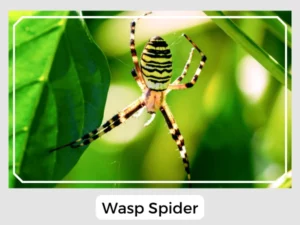The wasp spider is a unique member of the orb-weaver family. Originally from northern and Central Europe, you can also find them in parts of Asia and North Africa. Here, we will share some interesting facts about this spider to help you understand them better.
Eggs are laid in a cocoon-shaped sac made by female spiders.
After going through an overwintering process, young hatchlings arrive in the following spring
The spider makes a spiral web during dawn or dusk with the signature crisscross pattern at the center mostly used for attracting its prey.
Yes, wasp spiders are venomous. They use their venom mainly to paralyze their prey.
Wasp spiders can bite if they feel threatened. However, their bite is usually harmless to humans equivalent to a bee sting, causing only minor discomfort.
The wasp spider plays a vital role in maintaining the ecological balance within its habitat. By preying on various insects, it helps to control their populations, contributing to a healthier environment. The wasp spider is diurnal, meaning it is most active during the day, particularly when weaving its web and hunting.
Natural Predators: Despite its intimidating appearance, the wasp spider is not without its threats. Birds, larger spiders, and certain mammals pose a significant risk, preying on the wasp spider when the opportunity arises.
Prey-Predator Dynamics: The wasp spider and its predators engage in a delicate dance of survival, a dynamic interaction that highlights the complexity of nature’s food web. The spider’s venomous bite gives it a fighting chance against its prey, while its predators play a role in regulating its population.
Relationship with Humans: Generally, the wasp spider maintains a peaceful coexistence with humans. Their presence in gardens and grasslands can be beneficial, aiding in pest control. However, it’s crucial for humans to respect their space and avoid handling them, as their bite, though not harmful, can cause discomfort.
| Distribution | Northern and central Europe, Asia, north Africa, and archipelago |
| Habitat | Grassland and vegetations |
| Diet | Insects |
| Web Type | Orb |
| Lifespan | 1-3 years |
| Subspecies | Argiope bruennichini nigrofasciata |
| IUCN Conservation List | Not Listed |

In closing, the wasp spider stands as a testament to the diversity and complexity of the arachnid world.
The wasp spider is a unique member of the orb-weaver family. Originally from northern and Central Europe, you can also find them in parts of Asia and North Africa. Here, we will share some interesting facts about this spider to help you understand them better.
Eggs are laid in a cocoon-shaped sac made by female spiders.
After going through an overwintering process, young hatchlings arrive in the following spring
The spider makes a spiral web during dawn or dusk with the signature crisscross pattern at the center mostly used for attracting its prey.
Yes, wasp spiders are venomous. They use their venom mainly to paralyze their prey.
Wasp spiders can bite if they feel threatened. However, their bite is usually harmless to humans equivalent to a bee sting, causing only minor discomfort.
The wasp spider plays a vital role in maintaining the ecological balance within its habitat. By preying on various insects, it helps to control their populations, contributing to a healthier environment. The wasp spider is diurnal, meaning it is most active during the day, particularly when weaving its web and hunting.
Natural Predators: Despite its intimidating appearance, the wasp spider is not without its threats. Birds, larger spiders, and certain mammals pose a significant risk, preying on the wasp spider when the opportunity arises.
Prey-Predator Dynamics: The wasp spider and its predators engage in a delicate dance of survival, a dynamic interaction that highlights the complexity of nature’s food web. The spider’s venomous bite gives it a fighting chance against its prey, while its predators play a role in regulating its population.
Relationship with Humans: Generally, the wasp spider maintains a peaceful coexistence with humans. Their presence in gardens and grasslands can be beneficial, aiding in pest control. However, it’s crucial for humans to respect their space and avoid handling them, as their bite, though not harmful, can cause discomfort.
| Distribution | Northern and central Europe, Asia, north Africa, and archipelago |
| Habitat | Grassland and vegetations |
| Diet | Insects |
| Web Type | Orb |
| Lifespan | 1-3 years |
| Subspecies | Argiope bruennichini nigrofasciata |
| IUCN Conservation List | Not Listed |

In closing, the wasp spider stands as a testament to the diversity and complexity of the arachnid world.